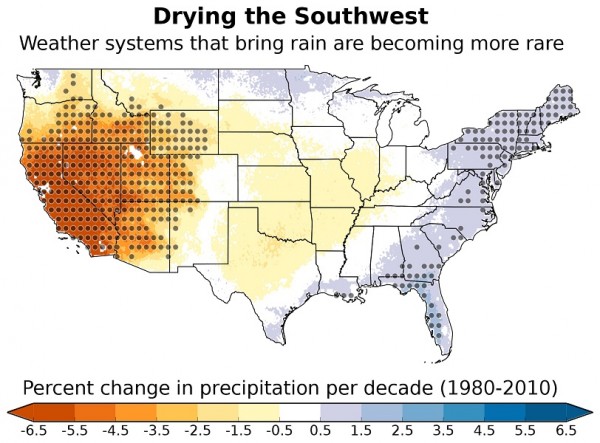By Ana Verayo, | February 07, 2016

Weather systems that typically bring moisture to the southwestern United States are forming less often, resulting in a drier climate across the region.
The Southwestern region of the United States is often considered to be the driest part of the country, where a new study reveals how drought has been more prevalent than ever, as wetter weather patterns are becoming drier than usual.
Like Us on Facebook
This can also lead to a dramatic change in weather patterns that can increase the occurrence of megadrought throughout the region. According to Andreas Prein from the National Center for Atmospheric Research, this has been a very intense trend in the Southwest, where the region could already enter into a drier climate state than before.
Prein and team examined weather patterns as opposed to average precipitation trends as the researchers have identified 12 major patterns, and only three of them are only prone to rain in the Southwest.
In this alarming finding, these three rainy patterns in the Southwest are also apparently becoming less frequent than before in the last 30 years, as amount of rainfall and mountain snow are now drying up faster than ever before.
Due to lesser rain and snow in an already arid region, these can eventually add up to a severe drought. Prior studies also say that there is also an 80 percent chance that the region can experience a megadrought that can last more than 20 years as the climate becomes warmer.
In this new study, these findings only support more evidence of an inevitable drought in the Southwestern U.S. Prein says that droughts today are not the same as 30 years ago, since they tend to become more intense and last longer too.
This new study also focuses on the major driving force of climate change in this region, which is this high pressure originating from the northeastern Pacific Ocean that drives away storms and rains from the region. Prein adds that this phenomenon can be detected in all observational datasets.
Lack of water resources can have a massive impact to the home of the nation's growing cities that are already experiencing scarce supply. Ecosystems and humans can only adapt to a certain degree when drier days become more common than ever, that can also have a lot of practical implications, according to Daniel Swain of Stanford University. Observing these pattern changes can also become more effective in understanding climate change and the natural impacts that come with it.
This new study is published in the journal, Geophysical Research Letters.
-
Use of Coronavirus Pandemic Drones Raises Privacy Concerns: Drones Spread Fear, Local Officials Say

-
Coronavirus Hampers The Delivery Of Lockheed Martin F-35 Stealth Fighters For 2020

-
Instagram Speeds Up Plans to Add Account Memorialization Feature Due to COVID-19 Deaths

-
NASA: Perseverance Plans to Bring 'Mars Rock' to Earth in 2031

-
600 Dead And 3,000 In The Hospital as Iranians Believed Drinking High-Concentrations of Alcohol Can Cure The Coronavirus

-
600 Dead And 3,000 In The Hospital as Iranians Believed Drinking High-Concentrations of Alcohol Can Cure The Coronavirus

-
COVID-19: Doctors, Nurses Use Virtual Reality to Learn New Skills in Treating Coronavirus Patients







